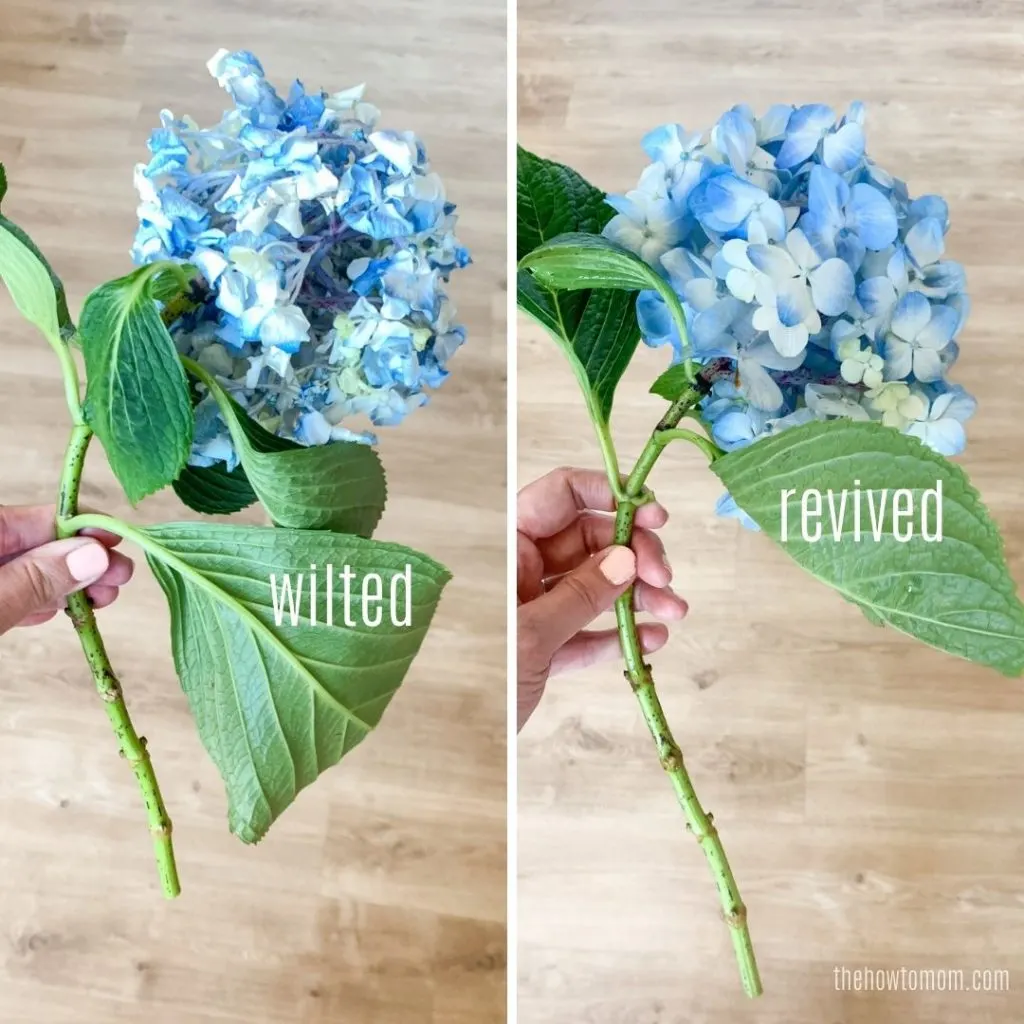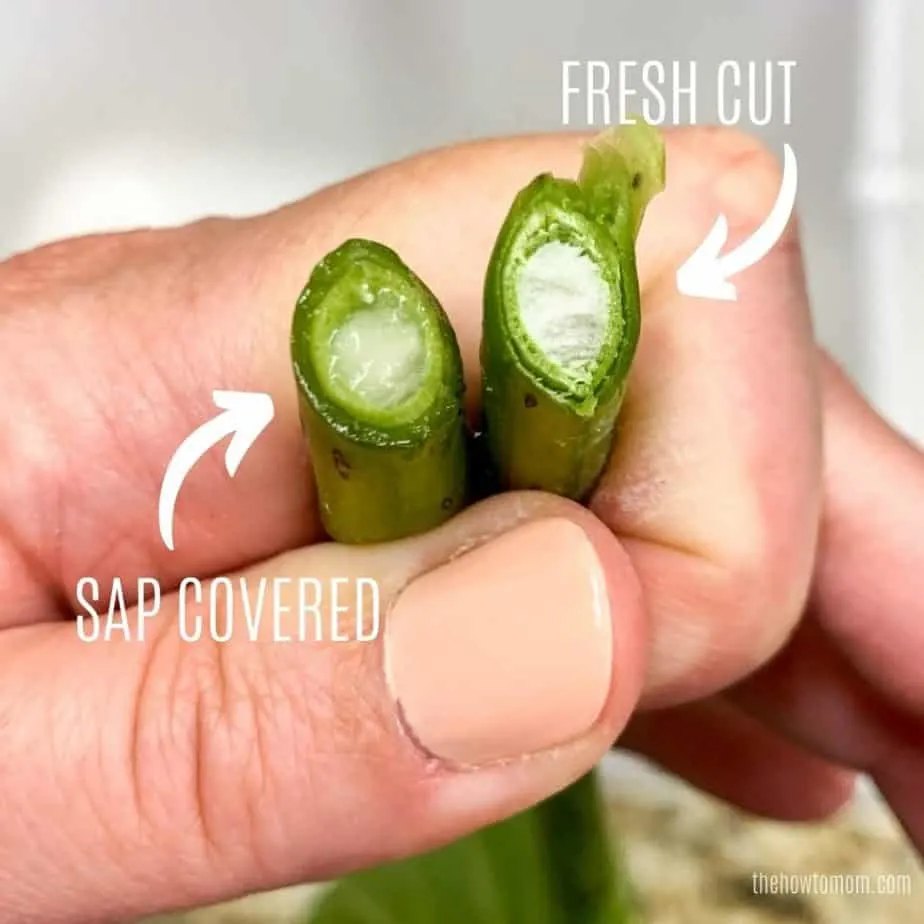- How to Make a Burlap Wreath – 3 Easy Styles! - May 30, 2022
- How to Revive Wilted Hydrangeas – Guaranteed! - July 28, 2021
- Easy Canvas Painting Ideas – 30+ DIYs for Beginners - June 16, 2021
Revive and perk up your droopy, wilting hydrangea stems with these two easy steps. No more sad, wilted hydrangeas, guaranteed!
Hydrangeas are my absolute favorite summer flower. I have made numerous faux hydrangea wreaths, like my Rainbow Hydrangea Wreath, Patriotic Hydrangea Wreath and Easy Summer Hydrangea Wreath. They’re such a lush beautiful bloom.
When we lived in Charleston, I planted a few pinkish-purple hydrangeas and loved tending them every summer. I’d water them in the mornings and marvel at their bright green buds and beautiful large leaves. And of course the blooms!!

These hydrangeas were only a few years old, so definitely not a huge shrub, but look at those colors! I love how one plant can have such a variety of shades of pinks and purples. And quite a few blooms for such a small plant.
As I lovingly cared for my hydrangea babies, I learned a few things. Hydrangeas love water! Their name comes from the latin word “hydra” which refers to water, and they absolutely need the perfect soil moisture to thrive outside. They also can’t handle too much sun, they do best with only a couple of hours of direct sunlight, preferably in the morning hours.
Now that I’m living in an area that isn’t super friendly to hydrangeas, I have to enjoy hydrangeas from the grocery store. My favorite place to find beautiful cut hydrangeas is Trader Joe’s or Costco. I’m especially a sucker for beautiful blue hydrangeas, swoon!

I quickly realized that cut hydrangeas wilt fast and often! It was so sad to wake up to sad drooping wilting hydrangeas the day after buying them!
I tried all the tricks, cutting the stems at an angle, adding fresh water to the vase, misting the blooms with water, even submerging the stems in cool water.
But frustratingly, sometimes the tricks would work, and sometimes they wouldn’t. So I began my quest to master the technique of reviving hydrangeas.

The good news is after much lovely trial and error, I am excited to share my guaranteed steps to reviving wilted hydrangeas.
Why do my cut hydrangeas wilt?
After doing some research, I learned that hydrangeas have woody stems which contains a sticky sap-like substance. Once the stems are cut, that clear sap starts to form over the bottom of the cut, blocking water from being able to to travel up the stem.

But re-cutting the hydrangea stems alone wasn’t always enough to revive them. Often by the time they start to wilt, they’re already pretty thirsty and just can’t suck water up their stems fast enough to recover.
Some hydrangeas will last a long time before dying, and others will start to wilt after a couple of hours. Its a beautiful gamble!
How to revive wilting hydrangeas
Step 1 – Re-cut the stem

The first thing we need to do is cut off the sap filled end of the stem. Sometimes you can cut 1/2″ off and that’s enough, and sometimes you need to cut deeper. There was one wilted hydrangea stem that I ended up having to cut off over 3 inches of stem to get up to the healthy part.
You can tell the difference between the healthy stem and the sap filled stem by looking at them. The picture below shows the difference, the stem on the left is covered in that clear sticky substance, and the stem on the right is a fresh cut, that will allow water to be absorbed.

So when you cut, make sure that the bottom of the stem looks dry and the inner color is an opaque, matte white. If you cut it and the end is still a darker, more translucent white, continue cutting until you get to the bright white insides.
Also, an angled cut is recommended for optimal water absorption.
Step 2 – Soak entire stem and bloom in warm water
After re-cutting the stems, submerge the entire stem in a large sink or bowl of warm water. You can use a clean kitchen or laundry room sink, or a large clean storage bin. Another good idea is using a bathtub, which will give the hydrangea stems plenty of room to soak.
Many other sources recommend cold water, but I have found that the hydrangeas respond best with lukewarm water. I have a theory that since they’re a “summer” flower, they prefer warm water over cool water.

I suggest using water that is about the temperature of a cooled bath, about 80 degrees F. I have scaled my hydrangeas before with water that was too hot, so you definitely don’t want to over do it. A little bit warmer than room temperature water is perfect. And make sure there is enough water in the sink to keep the end of the stem and the bloom submerged.
The freshly cut wilted hydrangeas need to soak until they are visibly revived and happy. I usually soak them for a couple of hours, but no longer than 4-5 hours. The petals can absorb too much wanter and turn translucent and die.
Another popular reviving trick is called the “boiling water method” and it entails placing the stems in scalding hot water for 30 seconds, presumably to melt any of that sticky substance, before soaking the entire stem and bloom in warm water. I have done it and it works, but isn’t always necessary.

Once the hydrangeas have fully bounced back, return them to a vase of water and enjoy!
You can repeat the reviving process as many times as you need to in order to revive your wilted hydrangeas. I had a particular stem that wilted every night, but bounced back every day for almost a week! Kind of a lot of work, but worth it for one of my favorite flowers.
Final tips for reviving hydrangeas
Multiple vases
You may want to have a couple types of vases available to use for you hydrangeas. A tall vase for when your hydrangeas are new and the stems are long, and a shorter vase for when the hydrangeas are on their last leg and their stems are short.
Remove extra leaves
Leaves can use up a lot of the water that the hydrangeas absorb. They are beautiful, but removing as many leaves as you can will leave more water for the blooms.
Try alum powder
Along with this method, many people suggest buying alum powder (from the spice section at the grocery store) and dipping the ends of the hydrangea stems into the powder when you bring the flowers home from the store, before putting them in the vase.
Don’t soak too long
There is a sweet spot for how long to soak the full hydrangea stems in the sink, you want them to perk up fully, but do not let them sit in the water too long, or the petals will start to take on too much water and become translucent and waterlogged and then shrivel up once you put them back in the vase.
Mist the blooms daily
If you live in a dry climate, or you’re running the AC a lot, you may have success preventing your hydrangeas from wilting by misting the blooms and leaves often with a spray bottle filled with water.
I hope this was helpful, I’d love to hear about your success stories with reviving your wilted hydrangeas.
Make Your Own Beautiful Living Succulent Wreath Centerpiece! Complete video course by Jeannine Romero now available through Skillshare.
